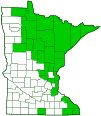northern groundcedar
(Diphasiastrum complanatum)
Conservation • Wetland • Description • Habitat • Ecology • Use • Distribution • Taxonomy
Description |
||
Northern groundcedar is an erect, evergreen, perennial club moss. It produces sparingly-branched horizontal stems (rhizomes) from which rise erect, vertical shoots. Fibrous roots emerge from the underside of the horizontal stems. The horizontal stems are green, 1 ⁄32″ to 1 ⁄16″ wide, and round in cross section. They appear on the surface of the ground, often shallowly buried under leaf litter. They are sparsely covered with tiny, scale-like leaves. Horizontal stem leaves are linear to narrowly lance-shaped, 1 ⁄16″ to ⅛″ long, 1 ⁄32″ to 1 ⁄16″ wide, and appressed or slightly spreading. They taper to a point at the tip with straight sides along the tip. Vertical stems can be 3″ to 11″ in height but are usually 4¾″ to 8″tall. They are 1 ⁄16″ to ¼″ in diameter, medium green, and sparsely covered with scale-like leaves. Vertical stem leaves are narrowly lance-shaped, 1 ⁄32″ to ⅛″ long, 1 ⁄64″ to 1 ⁄32″ wide, and appressed or slightly spreading. They extend down the stem at the base and taper to a point at the tip with straight or concave sides along the tip. Each vertical stem has 2 to 5 lateral branches. Lateral branches conspicuously broad, flattened, and held horizontally to the ground. They are irregularly divided into branchlets. Each of the branchlets are also divided. Eventually, the branches are divided successively usually 2 or 3 times but up to 5 times. The branchlets are 1 ⁄16″ to ⅛″ wide, flat in cross section, and held horizontally to the ground. They are abruptly and conspicuously narrowed (constricted) at the conjunction of successive years growth. The upper side is green, slightly shiny, and flat. The underside is pale green, dull, and flat. There are four column-like rows of leaves, one row along each edge and one row on each surface. Lateral leaves are linear lance-shaped, ⅛″ to ¼″ long, 1 ⁄32″ to 1 ⁄16″ wide, and appressed. Upper side leaves are similar but smaller. Under side leaves are narrowly triangular-shaped and much smaller. The reproductive structures (sporangia) are born in tight, cone-shaped structures (strobili). The strobili appear singly or in pairs, sometimes in clusters of 3 or 4, at the end of one or two stalks (peduncles) that rise from the tips of the vertical stems. The peduncles are forked at equal distances. The strobilus can be 5⁄16″ to 1¼″ long, but is usually ⅝″ to 1″ long and 1 ⁄16″ to ⅛″ wide. It is blunt at the tip and does not have a sterile tip. The leaf that bears the sporangium (sporophyll) is 1 ⁄16″ to ⅛″ long and wide and broadly triangular to nearly heart-shaped. The sporangium is kidney-shaped. |
||
Height |
||
Usually 4¾″ to 8″ |
||
Similar Species |
||
Habitat |
||
Dry. Coniferous forests. |
||
Ecology |
||
Sporulation |
||
July to October |
||
Pests and Diseases |
||
|
||
Use |
||
|
||
Distribution |
||||
|
Sources |
|||
| 4/27/2022 | ||||
Nativity |
||||
Native |
||||
Occurrence |
||||
Uncommon |
||||
Taxonomy |
|||
| Kingdom | Plantae (green algae and land plants) | ||
| Subkingdom | Viridiplantae (green plants) | ||
| Infrakingdom | Streptophyta (land plants and green algae) | ||
| Superdivision | Embryophyta (land plants) | ||
| Division | Tracheophyta (vascular plants) | ||
| Subdivision | Lycopodiophytina | ||
| Class | Lycopodiopsida | ||
| Subclass | Lycopodiidae | ||
Order |
Lycopodiales (clubmosses and firmosses) | ||
Family |
Lycopodiaceae (clubmosses and firmosses) | ||
| Subfamily | Lycopodioideae | ||
Genus |
Diphasiastrum (ground cedars) | ||
Club mosses in the genus Diphasiastrum readily crossbreed with other species in the same genus. The hybrids that are produced are fertile. Fertile hybrids are common in the animal kingdom but rare in the plant kingdom. |
|||
Subordinate Taxa |
|||
|
|||
Synonyms |
|||
Diphasium anceps Diphasium complanatum Diphasium complanatum ssp. montellii Diphasium wallrothii Lycopodium anceps Lycopodium complanatum Lycopodium complanatum ssp. anceps Lycopodium complanatum var. canadense |
|||
Common Names |
|||
Christmas green creeping jenny flat-branched club-moss groundcedar ground-cedar northern running-pine northern groundcedar trailing ground-pine |
|||
Glossary
Linear
Long, straight, and narrow, with more or less parallel sides, like a blade of grass.
Peduncle
In angiosperms, the stalk of a single flower or a flower cluster; in club mosses, the stalk of a strobilus or a group of strobili.
Rhizome
A horizontal, usually underground stem. It serves as a reproductive structure, producing roots below and shoots above at the nodes.
Sporangium
A spore bearing structure, as of a fern or moss.
Sporophyll
A modified leaf that bears one or more sporangia.
Sporulation
The process of forming spores.
Strobilus
A cone-like structure of horsetails (Equisetaceae) and clubmosses (Lycopodiaceae) composed of sporophylls densely arranged along a central axis.
Visitor Photos |
|||||
Share your photo of this plant. |
|||||
| This button not working for you? Simply email us at info@MinnesotaSeasons.com. Attach one or more photos and, if you like, a caption. |
|||||
|
|||||
MinnesotaSeasons.com Photos |
|||||
Habitat |
|||||
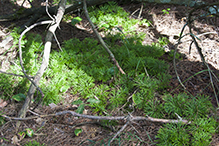 |
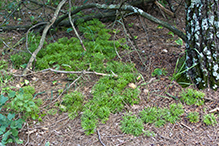 |
||||
Plant |
|||||
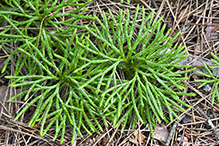 |
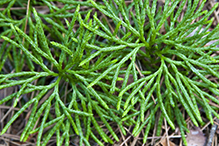 |
||||
Lateral Branches |
|||||
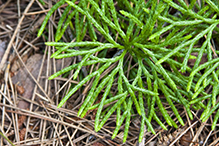 |
|||||

Slideshows |
||

Visitor Videos |
|||
Share your video of this plant. |
|||
| This button not working for you? Simply email us at info@MinnesotaSeasons.com. Attach a video, a YouTube link, or a cloud storage link. |
|||
Other Videos |
|||
| Diphasiastrum complanatum i D. zeilleri w Gorcach. PoznajBeskidy |
|||
About
Dec 15, 2018 Wspaniałe stanowisko rzadkiego widlicza spłaszczonego (Diphasiastrum complanatum) i widlicza Zeillera (Diphasiastrum zeilleri) na południowym stoku Bukowiny Obidowskiej (1039m n.p.m.) w Gorcach. Google Translate: A magnificent stand of the rare flattened specters (Diphasiastrum complanatum) and Zeiller's specters (Diphasiastrum zeilleri) on the southern slope of Bukovina Obidowska (1039m above sea level) in Gorce. |
|||

Visitor Sightings |
|||||
Report a sighting of this plant. |
|||||
| This button not working for you? Simply email us at info@MinnesotaSeasons.com. Be sure to include a location. |
|||||
| Judy 4/26/2022 |
Location: Crow Wing St. Park |
||||
MinnesotaSeasons.com Sightings |
|||||

|
Created: Last Updated: © MinnesotaSeasons.com. All rights reserved. |
